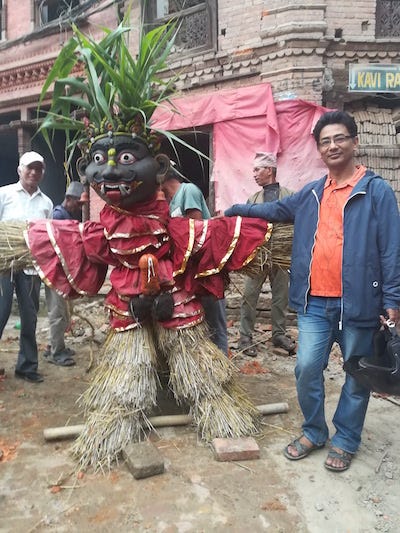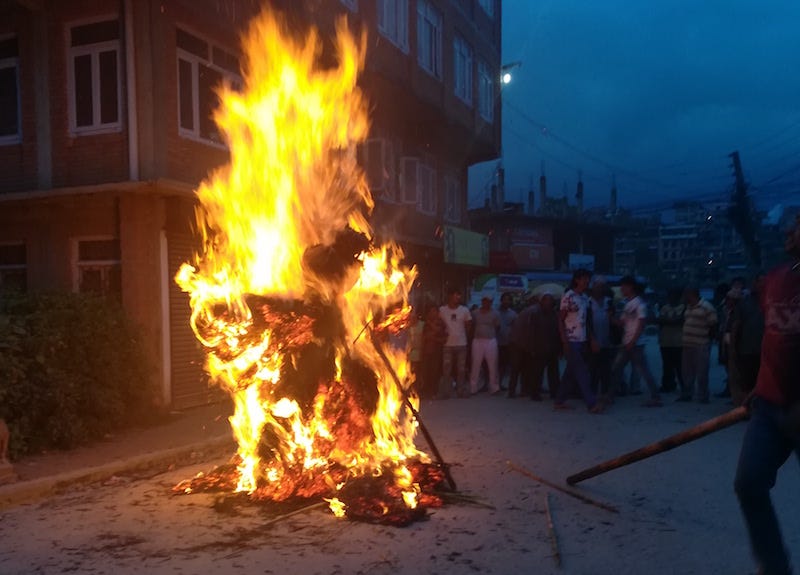Razen Manandhar
Newars, a small community in Nepal, celebrate a score of festivals throughout the year. It is strange that no other community in the multi-ethnic county has this many festivals. Sometime it’s a matter of pride, and sometime, actually, it is a burden to new generation that has to do so many things in this competitive world, than rejoicing festivals.
Among others, the festival of Gathamuga (गथांमुगः) is unique, strange or even bizarre. This is not even religious, one can say. It is, just a cultural event, which is not related to any of religions the Newars follow. So, no particular god or goddess is worshipped on this day, as it usually happens with other Newar festivals. This year, in 2018, the festival fell on August 9th.
Chasing away a horrible demon is what is done on this day, basically. An effigy, made of freshly cut reed plants, which must have a huge mask with terrifying eyes, teeth showing face, big ears with bells as ear pendants. Interesting thing about this demon is, it does not matter whether it has any other detail or not, but a quite big and noticeable sexual organ, of course male, is what it must carry. Isn’t obscene? I will talk about it later.
The making of effigy is related with a legend. As the legend has it, once upon a time, there was a man-eating demon (some call it helpful ghost). People, tired of his atrocity, chose a Trantric to take this story to an end. He disguised himself as a frog and when in front of the demon and started teasing him. The demon was quite furious and started chasing him. The frog led him to a marsh and he died. The locals were delighted with his death and they all cremated him in the jungle. Now, people celebrate the death of this legendary demon every year.
And, some elites, or say, theists, have another version of the story. They believe that Gathamuga was not a demon, but just an atheist. He did not like to hear name of any god and so, he had bells as his earrings. And he was rejected by the society. When he died, he died so miserably that he did not have anybody to cremate his body. So, people picked a boy to collect donation and his body was cremated in the river. This is the reason that people in Kathmandu these days take the effigy to the river, led by a boy, who begs money for the last ritual. However this boy’s role in the story is seen only in Kathmandu.
This festival is called “boy’s festival”, where girls don’t have much to do. It might be said so because, the effigy is made which looks obscene. There is particular reason why the demon is male (I know there were some female demons too, which also were made with their organs equally visible, but they are, I am afraid it is extinct now). One should not have any objection about these things because Nepal is one of the countries where phallus is worshipped publicly. In Nepal and India, the Hindus worship giant phalluses are worshiped in the form of Shiva, one of the major deities of the religion. And apart from the Hindus of this region, others also have a kind of religious affection to male genital organs, for example the Japanese and the Bhutanese, and this is all no nonsense. Everybody knows that it is the source of origin or, at lease we can say now, reproduction. Yes, some like Hindus have explanations with philosophic coating and others are all name rustic or barbarians who practice phallus-worshipping without explaining. Thank god, we don’t encourage or glorify male chauvinism or rapists or molesters by doing this. Apart from this, some obscene slogans are shouted in the procession. They also don’t have answer when asked why they have to shout like this. All they have to reply is, “We have been doing this for ages. And we have to do.” But we know this is one simple way to vent out frustration, anger out of their mind and a chance to express their hard-trodden desire to say some “prohibited” words, at least once a year.
Well, what do they do on this day? From the morning, women folks clean their houses and paint their main door’s with crimson-colored-clay with some mixture of cow-dung. Even though we say that girls don’t have role, this part of the difficult task is mostly done by the women. People love to wear iron rings on this day, saying that this will protect them the demon’s touch.
And boys erect small effigies in most of the crossroads in the morning. And again, most of talented women make dolls or leftover clothes and hang them on those effigies. They say that it is the demon Gathamuga and the dolls symbolize those poor children, taken away by him.
By afternoon, the local boys, mostly adolescent boys go around the locality to collect some money to buy reeds. They used to shout some obscene slogans too! With that much of money, they buy other stacks of freshly cut reed plants.
And by evening, grown up men of the locality make another giant effigy of the demon (some seven to ten feet tall), erect it at the crossroad and add big colorfully painted posters of masks as well as those organs.
The locals pick a boy, obviously a beggar, to play role as the “son of Gathamuga”. They also paint something obscene on his body and take him along the street to collect money from shops and households. All the money becomes his (and the locals guard that boy carefully, because most of the time such boys are clever enough to collect all the money and scape the scene without doing his final rites).
The locals give the boy a plate of curd and rice-flakes and make him ready. They give him a bunch of burning reed and ask him to set fire on it. As he does, people fell the effigy, make that boy sit on tit and pull it along the road to a nearby river. And they all throw the reed in the river and come back home, saying that the demon will not disturb us again we need to clean our home and get ready for the series of the festival that are to follow throughout the year. Apart from this, people in each home prepare three bowls with rice husk, some pieces of meat and flowers and take them to three corners of the locality. This is how the festival ends in Kathmandu that I have been watching curiously since childhood.
This year, I decided to go to Bhaktapur, a city around 9 km east of Kathmandu. This city is famous for their wood-work, brick-work and magnificent masons for constructing traditional house. And of course, for their immense love for their culture too. Now, it is not difficult to go on motorcycle, thanks to the Japanese government for making us new highway.
I always enjoy being there for sometime. It is not very far but they have been doing their best to keep it safe from outsiders, encroachers and squatters. This is the reason that they have been successful to preserve their tangible heritage, that is those 17th century marvelous temples, courtyards, rest-houses and water spouts. And so are they determined to preserve their intangible heritage like, say, this Gathamugaa.
Well, it was freshly trickling when I left home but the sky was clear there. As it was too early for the events to begin, I thought it would be nice to meet some Nepalbhasha writers there. They offered me some cold yoghurt and hot momos. We talked about culture, festivals and literature of our mother language. It was such a nice time to be with them. A small but all committed to safeguard our mother language, which is now endangered, so to say.
Then they led us to some core of the old traditional settlements. The effigies were being erected and the symbols were being joined. All men, women, boys and girls were watching it, laughing and being little blushed. But they have internalized that it is not shame, it is just some fun for them. This is how they teach growing adolescent in those days.
Specially, in the potters’ square, they make huge masked heads, out of some freshly baked pots. They work so hard, for some days, to make that gigantic face of the fiercely smiling demon, and the signs too. And, they know that those things of art will be destroyed after half an hour. But, they do their best to decorate the effigies, because they know the people form their neighboring crossroads are coming to see who is doing the best in the whole city. What a competition !
The evening was getting darker and the whole area was changing smoky. The two-sided drums and big copper cymbals were supporting people’s daring shouts. You wont ask them to repeat the slogans, once you get hints that it was terribly obscene. Some people were carrying burning straw-bunches and moving them to the air. They were also carrying those demons, shaking them terribly from two sides. The horrible masks were making faces at the passersby.
They crossed the small river, much encroached these days, and took the effigy there. That part of the city must be barren jungle in the past, nevertheless, now surrounded by newly built buildings. They erected it in the middle of the road somehow and suddenly bright yellow flame gulped the whole of the reed effigy. The boys were shouting the slogans and the drums where smart to make the slogan voice dim, so that others may not pay attention to the meaning of them.
Goodbye demon. Come again next year, we will burn you again.
Published in Medium.com : https://medium.com/@razenmanandhar/go-away-you-sexy-demon-e9d2cd32ce44






No comments:
Post a Comment